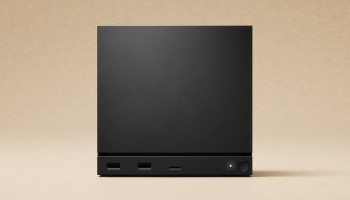
The image shows a woman wearing an Apple Vision Pro. — Apple
Since there's a huge difference in their prices, comparing or seeking a comparison between Apple's Vision Pro and Meta Quest Pro might seem a joke to any sane person, which is understandable.
But considering the backlash, returns, and bad word of mouth from some of the frequent Apple users provide us with an aerial view of possibilities surrounding the defeat of Vision Pro at the hands of Meta Quest Pro.
Areas wherein Vision Pro smoothly beats Meta Quest Pro include micro-OLED and high-res 4K displays, better hand tracking, eye tracking, sophisticated features, top-class constituents used in the making (metal-and-glass chassis in Vision Pro vs plastic in Meta Quest Pro). Let's forget all this for a moment and head to have a face-off between the two and discover the factors that make the Quest Pro 3 better than the Vision Pro.
Read more: Apple Vision Pro vs Meta Quest 3 — Which one is living up to the bar?
Comparison of Apple Vision Pro with Meta Quest Pro
Design and hardware
The Apple Vision Pro and Meta Quest Pro are compared like a premium flagship smartphone to a more affordable model. The Vision Pro has a sleek metal and glass design, while the Quest Pro is larger, boxier, and made of black plastic.
The Quest Pro is 44% heavier than the base level Quest 2 model. The Quest Pro includes physical motion controllers and a charging dock, while the Vision Pro detects finger and hand movements using cameras and sensors and supports Bluetooth gamepads for video games.
Visuals
This is where we can say that Apple has gone head-on with what and how good you see something on the high-end headset, as it offers a batter display then 4K for each eye with over 23 million pixels between both. On the other hand, the Meta Quest Pro offers a resolution of 1,920 x 1,800 per eye, after collecting about 7 million pixels in total. It's now crystal clear that VIsion Pro has more crispy and sharper display no matter what.
Performance
Comparison in this aspect is more like the one between a computer and a smartphone, as the Vision Pro is backed by M2 processor used inside Apple’s latest top-of-the-line laptops and a distinguished chip designed specifically to read camera and sensor data.
Read more: Vision Pro supported apps — Microsoft 365, Zoom atop the list
Meanwhile, the Quest Pro uses Qualcomm’s Snapdragon XR2+ chip, something designed for headsets but ultimately serves smartphones better than headsets since it falls under the most used smartphones chips. Given that, the Vision Pro extends a way better immersive experience than Meta Quest Pro.
Battery
The average battery life, offered on both the Vision Pro and Meta Quest Pro, is pretty much similar, as the Vision Pro can bear up to two hours straight with the Meta Quest Pro falling slightly short of it. The outstanding difference is that Quest 3's battery is put inside the headset, while that of Vision Pro battery is external, requires a cord-connection. Both the headsets are usable when plugged into a wall.
Content collection
As the company promised, the Vision Pro offers a range of productivity features including floating windows, web browsers. Extending the scope of offered content, this also brings on the table countless games and apps, most notable among them being the video calling apps such as FaceTime.
The Apple Vision Pro headset can capture and display 3D photos and videos, and run interactive apps and games, including iOS games from Apple Arcade subscription. It benefits from Apple's existing collection of apps, games, and services. In contrast, Meta does not offer the same variety of apps and features but has developed VR apps and games over the past few years.
















